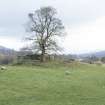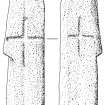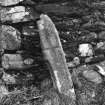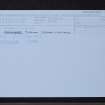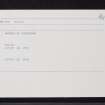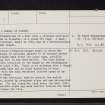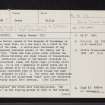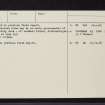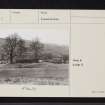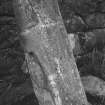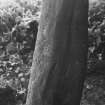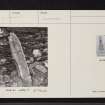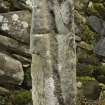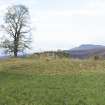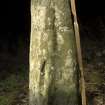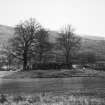Pricing Change
New pricing for orders of material from this site will come into place shortly. Charges for supply of digital images, digitisation on demand, prints and licensing will be altered.
Suie, Macnabs Of Innishewan Burial Enclosure
Burial Ground (18th Century), Cross Incised Stone (Early Medieval), Grave Marker (Early Medieval), Grave Marker(S) (Post Medieval)
Site Name Suie, Macnabs Of Innishewan Burial Enclosure
Classification Burial Ground (18th Century), Cross Incised Stone (Early Medieval), Grave Marker (Early Medieval), Grave Marker(S) (Post Medieval)
Canmore ID 23948
Site Number NN42NE 3
NGR NN 49004 28003
Datum OSGB36 - NGR
Permalink http://canmore.org.uk/site/23948
- Council Stirling
- Parish Killin
- Former Region Central
- Former District Stirling
- Former County Perthshire
Field Visit (26 June 1962)
The rather irregular-shaped mound on which the burial ground is situated appears to be natural except for the slight bank round its upper edge, possibly indicating that it was once walled. The only traces of any other structure on the mound is the rectangular enclosure dated 1759. There is no evidence that a chapel ever existed here and no local tradition of such. The slab with the much weathered incised cross is as described above.
There are certainly burials outside the walled enclosure, marked by recumbent slabs and one uninscribed headstone. The one inscribed slab bears the date 1766. The uniscribed slabs may mark earlier burials but there is no evidence for this.
Visited by OS (EG) 26 June 1962
Desk Based Assessment (1962)
'Caipals' are often mere burying-places. The 'Caipal' in the burying ground at Suie is the burying place of a family of McNabs.
J Anderson 1889
The burial ground of the Macnabs of Inishewan is at Suie, near Luib, on a low knoll in a field to the north of the road. A rectangular enclosure of dry stone masonry contains graves of the family and is dated 1759. There are some plain slabs outside the low roofless building and clear traces of foundations. At the south-east corner of the Macnab enclosure is a cross-incised slab, 3ft 8 1/2ins high, probably still is situ. It is not a memorial or grave cross and is prossibly coeval with St Fillan (Suie in Glen Dochart is locally connected with St Fillan though his name is not attached to it (W J Watson 1926)). The cross and foundations together with the place-name 'Suie" make the existence of an early chapel here certain.
A D Lacaille 1929
The foundations of a wall form a circular enclosure c.20 yards in diameter, on a mound 8ft high. A small square structures, built in 1759, may be a reconstruction of an older chapel.
W A Gillies 1938
NN 490 279 An early cross-slab, bearing a small incised cross on each face, stands close to the burial-ground of the Macnabs of Inishewan at Suie.
RCAHMS 1979, visited September 1978
A D Lacaille 1929
Information from OS Index Card c.
Sources: J Anderson 1889; A D Lacaille 1929; W A Gillies 1938; RCAHMS 1979
Field Visit (29 April 1969)
As described in previous field report. The cross-incised stone may be an early-marker of 6th-7th century date (cf. Ardwall Island, Kirkcudbrightshire, and at Iona (A C Thomas 1966).
Surveyed at 1:2500.
Visited by OS (WDJ) 29 April 1969
Field Visit (12 December 1978)
No change to previous field report.
Visited by OS (BS) 12 December 1978
Field Visit (September 1978)
Suie, Cross-slab and Burial-ground NN 490 279 NN42NE 3
An early cross-slab, bearing a small incised cross on each face, stands close to the burial ground of the Macnabs of Inishewan at Suie.
RCAHMS 1979, visited September 1978
(Lacaille 1929, 346-7)
Field Visit (1 March 2010 - 17 March 2010)
Alder Archaeology was commissioned by Mrs Emma Paterson, Auchlyne to undertake an archaeological survey of the McNab burial ground at Suie in Glen Dochart, by Killin. The survey was to be a record of the site prior to tree removal and remedial works to the enclosure which was in an unstable condition. The archaeological work comprised a topographical survey of the site, a written record of the memorials and grave markers, a photographic record and probing to find any buried slabs. It was noted that an early cross-incised stone had started to fracture.
Archive: RCAHMS
Funder: Loch Lomond and The Trossachs National Park Authority
Ray Cachart, Alder Archaeology Ltd 2010




























